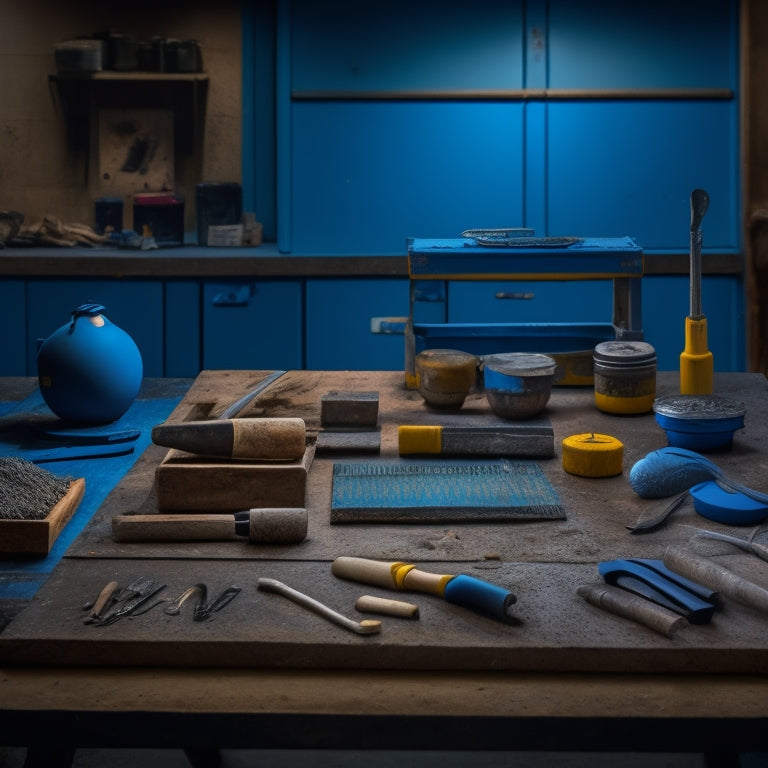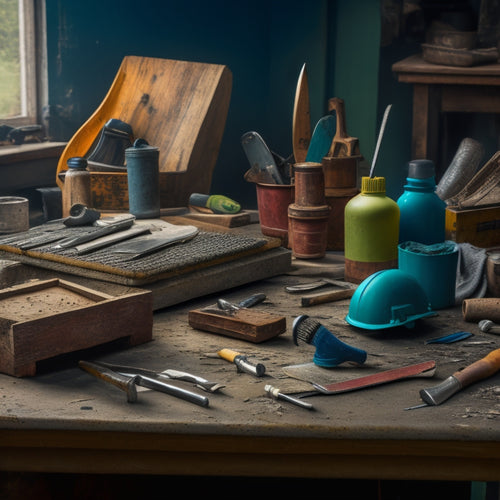
Top 5 Tools for Effective Concrete Sealing
Share
When it comes to effective concrete sealing, you need the right tools to get the job done. Essential sealant application brushes with synthetic bristles guarantee even distribution and streak-free finishes. High-pressure sprayer systems cover large areas quickly, while sealant spreader and squeegee tools are must-haves for tight spaces. Don't forget concrete surface cleaning machines for thorough prep work, and precision sealant injection guns for accurate dispensing in cracks and crevices. With these top 5 tools in your arsenal, you'll set yourself up for success. Now, learn how to choose the right tools for your specific project and take your concrete sealing skills to the next level.
Key Takeaways
• High-quality sealant application brushes with synthetic bristles ensure even distribution and prevent streaks and bubbles.
• High-pressure sprayer systems are ideal for large-scale projects, covering vast areas quickly and efficiently.
• Sealant spreader and squeegee tools are essential for applying sealants in tight spaces and corners with consistent flow rates.
• Concrete surface cleaning machines, such as pressure washers and rotary floor cleaners, provide thorough surface cleaning before sealant application.
• Precision sealant injection guns accurately dispense sealant in cracks and crevices, suitable for various viscosities and crack sizes.
Essential Sealant Application Brushes
When applying a concrete sealer, you'll need a high-quality brush that can effectively distribute the sealant without leaving streaks, bubbles, or other imperfections. A good brush is vital for achieving a uniform, professional-looking finish.
Look for a brush with synthetic bristles, as they're more durable and resistant to solvents. The brush's nap length should be suitable for the type of sealer you're using – longer naps for thicker sealers and shorter naps for thinner ones.
To guarantee ideal application techniques, it's important to maintain your brush properly. Regularly clean your brush with a solvent, and let it air-dry to prevent damage.
Store your brush in a dry place, away from direct sunlight, to prolong its lifespan. Before reusing your brush, inspect it for worn or damaged bristles and replace them as needed.
Proper brush maintenance will help you achieve consistent, high-quality results. By investing in the right brush and following these best practices, you'll be able to achieve a flawless, long-lasting concrete seal.
High-Pressure Sprayer Systems
Frequently, high-pressure sprayer systems are the go-to choice for large-scale concrete sealing projects, as they enable you to quickly and efficiently cover vast areas with a uniform coat of sealant. These systems typically consist of a pump, hose, and spray gun, allowing you to accurately control the application process.
| Sprayer Component | Maintenance Technique | Pressure Adjustment Method |
|---|---|---|
| Pump | Regularly check and replace worn seals | Adjust pump pressure to achieve ideal flow rate |
| Hose | Inspect for kinks and damage, replace as needed | Monitor hose pressure to prevent damage |
| Spray Gun | Clean orifices regularly to prevent clogging | Adjust spray pattern to achieve uniform coverage |
| Filters | Replace filters every 3-6 months or as needed | Check filter condition to guarantee ideal flow |
| Pressure Regulator | Check and adjust regulator regularly | Monitor pressure gauge to guarantee accurate readings |
When using high-pressure sprayer systems, it is crucial to follow proper sprayer maintenance techniques and pressure adjustment methods to guarantee ideal performance and extend the lifespan of your equipment. By doing so, you'll be able to achieve a professional-grade finish and maximize your productivity on the job site.
Sealant Spreader and Squeegee Tools
As you move on to smaller, more detailed concrete sealing projects, you'll often rely on sealant spreader and squeegee tools to achieve a smooth, even finish. These tools are important for applying sealants to tight spaces, edges, and corners.
When using a sealant spreader, it's critical to maintain a consistent flow rate to prevent uneven application. You can achieve this by adjusting the spreader's width and applying gentle to moderate pressure.
To guarantee a professional-looking finish, it's essential to master proper sealant application techniques. This includes using the correct angle and pressure when applying the sealant, as well as maintaining a steady pace.
Additionally, regular squeegee maintenance tips include cleaning the tool after each use and storing it in a dry place to prevent damage. A well-maintained squeegee is important for removing excess sealant and achieving a smooth finish.
Concrete Surface Cleaning Machines
You'll need to clean the concrete surface thoroughly before applying a sealant, which is where concrete surface cleaning machines come into play, offering an efficient way to remove dirt, grime, and other substances that can compromise the sealant's adhesion. These machines are vital for concrete surface preparation, guaranteeing a strong bond between the sealant and the concrete. Effective stain removal techniques are significant, and these machines make it possible to achieve professional-grade results.
| Machine Type | Cleaning Method | Surface Preparation |
|---|---|---|
| Pressure Washer | High-pressure water jet | Removes dirt, grime, and loose material |
| Rotary Floor Cleaner | Rotating brushes and water | Agitates and removes stubborn stains |
| Industrial Vacuum | Powerful suction | Removes dirt, dust, and debris |
When selecting a concrete surface cleaning machine, consider the type of stain, the size of the area, and the level of cleaning required. By using the right machine for the job, you'll guarantee a clean, prepared surface that's ready for sealing. Remember, a clean surface is vital for a successful sealant application, and these machines are the key to achieving that.
Precision Sealant Injection Guns
With precision sealant injection guns, you can accurately dispense sealants into cracks and crevices, ensuring a uniform application and minimizing waste. These guns are designed to handle a wide range of sealant viscosities, from thin polyurethanes to thick epoxies, allowing you to tackle various concrete sealing projects with confidence.
When selecting a precision sealant injection gun, consider the type of sealant you'll be working with and the specific injection techniques required. For instance, if you're dealing with hairline cracks, a gun with a fine nozzle tip and low-pressure output may be ideal. On the other hand, larger cracks may require a gun with a larger nozzle and higher pressure output.
Look for guns with adjustable pressure controls, which enable you to fine-tune the flow rate to suit the specific application. Additionally, consider guns with ergonomic designs and comfortable grips, which reduce fatigue and improve control during extended use.
Frequently Asked Questions
How Often Should I Reapply Concrete Sealant for Optimal Protection?
When it comes to reapplying concrete sealant, you're likely wondering how often to do it for ideal protection.
The reapplication frequency depends on the sealant's lifespan, which varies depending on factors like foot traffic, climate, and sealant type. Typically, you'll need to reapply every 1-3 years, but this can range from 6 months to 5 years.
You'll know it's time when you notice a decrease in water repellency or an increase in staining.
Can I Use a Regular Broom to Sweep the Concrete Before Sealing?
'An ounce of prevention is worth a pound of cure' - and that's especially true when preparing your concrete for sealing.
When it comes to sweeping, you'll want to ditch the regular broom for a soft-bristled, nylon-brush broom or a push broom with synthetic bristles.
These broom types are gentler on the concrete and will prevent scratching.
Use gentle, overlapping sweeping techniques to remove dirt and debris, ensuring a clean surface for ideal sealant adhesion.
Is It Necessary to Test the Concrete Sealant on a Small Area First?
When applying a concrete sealant, you'll want to test it on a small area first to ascertain sealant compatibility with the concrete's unique chemistry.
This vital step helps you identify potential issues with surface preparation, such as porosity or moisture levels, that could affect the sealant's performance.
Will Using a High-Gloss Sealant Make the Concrete More Slippery?
You're wondering if using a high-gloss sealant will make the concrete more slippery.
The answer lies in understanding slip resistance and surface texture. High-gloss sealants can indeed reduce slip resistance, especially on smooth surfaces.
However, by incorporating a textured finish or adding aggregate to the sealant, you can maintain traction while still achieving a high-gloss appearance.
It's crucial to strike a balance between aesthetics and safety, ensuring your sealed concrete surface meets both your visual and functional requirements.
Can I Seal Concrete During Extreme Weather Conditions Like Rain or Direct Sunlight?
When it comes to sealing concrete, you're playing with fire if you attempt to do it in extreme weather conditions.
Rain and direct sunlight can be a recipe for disaster, causing the sealant to bubble, peel, or discolor.
You must wait for a window of moderate weather to guarantee a successful seal.
Understand the weather impact on your sealing techniques and plan accordingly to achieve a durable, long-lasting finish that will make your concrete shine like new.
Conclusion
You've made it to the finish line, and now your concrete sealing project is about to get a whole lot easier.
Gone are the days of mediocre results and wasted time. With these top 5 tools, you'll be sealing like a pro in no time.
The amateurish struggles of the past will be replaced with precision, efficiency, and a job well done.
So, gear up and get ready to take your concrete sealing game to the next level!
Related Posts
-

Essential Tools for Concrete Wall Covering Projects
When tackling a concrete wall covering project, you'll need a range of essential tools and equipment. For cleaning an...
-

Must-Have Handheld Tools for Concrete Repair
When tackling a concrete repair project, it is crucial to have the right handheld tools to achieve a professional fin...
-

Essential Tools for Epoxy Concrete Floor Repair
You'll need a thorough arsenal of specialized tools to guarantee a successful epoxy concrete floor repair. Floor prep...


